
The Temple in Jerusalem, or alternatively the Holy Temple, refers to the two now-destroyed religious structures that served as the central places of worship for Israelites and Jews on the modern-day Temple Mount in the Old City of Jerusalem. According to the Hebrew Bible, the First Temple was built in the 10th century BCE, during the reign of Solomon over the United Kingdom of Israel. It stood until c. 587 BCE, when it was destroyed during the Babylonian siege of Jerusalem. Almost a century later, the First Temple was replaced by the Second Temple, which was built after the Neo-Babylonian Empire was conquered by the Achaemenid Persian Empire. While the Second Temple stood for a longer period of time than the First Temple, it was likewise destroyed during the Roman siege of Jerusalem in 70 CE.

The Temple Mount, also known as al-Ḥaram al-Sharīf, al-Aqsa Mosque compound, or simply al-Aqsa Mosque, and sometimes as Jerusalem's sacredesplanade, is a hill in the Old City of Jerusalem that has been venerated as a holy site in Judaism, Christianity, and Islam for thousands of years.
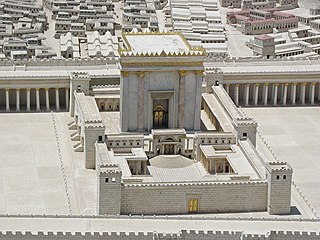
The Second Temple, later known as Herod's Temple, was the reconstructed Temple in Jerusalem between c. 516 BCE and 70 CE. It replaced Solomon's Temple, which is presumed to have been built at the same location before its destruction by the Neo-Babylonian Empire during the Babylonian siege of Jerusalem in c. 587 BCE. Construction on the Second Temple began some time after the Neo-Babylonian Empire was conquered by the Achaemenid Persian Empire; it followed a proclamation by Persian king Cyrus the Great that ended the Babylonian captivity and initiated the return to Zion. In Jewish history, the Second Temple's completion in Persian Judah marks the beginning of the Second Temple period.
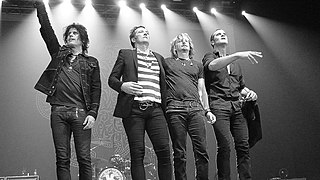
Stone Temple Pilots is an American rock band from San Diego, California, that originally consisted of Scott Weiland, brothers Dean (guitar) and Robert DeLeo, and Eric Kretz (drums). The band's lineup remained unchanged from its formation in 1989 until the firing of Weiland in February 2013. Linkin Park vocalist Chester Bennington joined the band in May 2013 but left amicably in November 2015. In 2016, the band launched an online audition for a new lead vocalist; they announced Jeff Gutt as the new lead singer on November 14, 2017.

Indiana Jones and the Temple of Doom is a 1984 American action-adventure film directed by Steven Spielberg. It is the second installment in the Indiana Jones franchise, and a prequel to the 1981 film Raiders of the Lost Ark, featuring Harrison Ford who reprises his role as the title character. Kate Capshaw, Amrish Puri, Roshan Seth, Philip Stone, and Ke Huy Quan star in supporting roles. In the film, after arriving in India, Indiana Jones is asked by desperate villagers to find a mystical stone and rescue their children from a Thuggee cult practicing child slavery, black magic, and ritual human sacrifice in honor of the goddess Kali.

The International Society for Krishna Consciousness (ISKCON), known colloquially as the Hare Krishna movement or Hare Krishnas, is a Gaudiya Vaishnava Hindu religious organization. ISKCON was founded in 1966 in New York City by A. C. Bhaktivedanta Swami Prabhupada.

Angkor Wat is a temple complex in Cambodia and is the largest religious monument in the world, on a site measuring 162.6 hectares. Originally constructed as a Hindu temple dedicated to the god Vishnu for the Khmer Empire by King Suryavarman II during the 12th century, it was gradually transformed into a Buddhist temple towards the end of the century; as such, it is also described as a "Hindu-Buddhist" temple.

The Peoples Temple Agricultural Project, better known by its informal name "Jonestown", was a remote settlement in Guyana established by the Peoples Temple, a U.S.-based cult under the leadership of Jim Jones. Jonestown became internationally infamous when, on November 18, 1978, a total of 909 people died at the settlement, at the nearby airstrip in Port Kaituma, and at a Temple-run building in Georgetown, Guyana's capital city. The name of the settlement became synonymous with the incidents at those locations.

James Warren Jones was an American preacher, political activist, and mass murderer. He led the Peoples Temple, a new religious movement, between 1955 and 1978. In what he called "revolutionary suicide", Jones and the members of his inner circle orchestrated a mass murder-suicide in his remote jungle commune at Jonestown, Guyana, on November 18, 1978. Jones and the events that occurred at Jonestown have had a defining influence on society's perception of cults.

Temple University is a public state-related research university in Philadelphia, Pennsylvania. It was founded in 1884 by the Baptist minister Russell Conwell and his congregation Grace Baptist Church of Philadelphia then called Baptist Temple. On May 12, 1888, it was renamed the Temple College of Philadelphia. By 1907, the institution revised its institutional status and was incorporated as a research university.
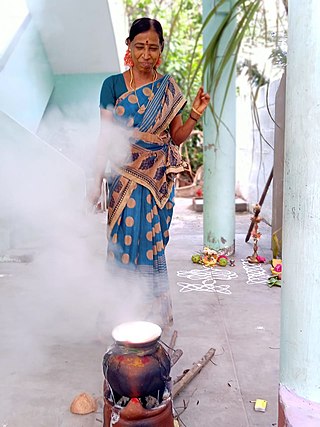
Pongal, also referred to as Thai Pongal (தைப்பொங்கல்), is a multi-day Hindu harvest festival celebrated by Tamils in India and Sri Lanka. It is observed at the start of the month Thai according to Tamil solar calendar, and this festival is celebrated usually on January 14 or January 15 depending on the sun's orbit around earth that particular year. It is dedicated to the sun god, Surya, and corresponds to Makar Sankranti, the harvest festival under many regional names celebrated throughout India. The three days of the Pongal festival are called Bhogi Pongal, Surya Pongal, and Mattu Pongal. Some Tamils celebrate a fourth day of Pongal known as Kanum Pongal.

Shirley Temple Black was an American actress, singer, dancer, and diplomat who was Hollywood's number one box-office draw as a child actress from 1934 to 1938. Later, she was named United States ambassador to Ghana and Czechoslovakia, and also served as Chief of Protocol of the United States.

A Hindu temple, or mandir or koil in Indian languages, is a house, seat and body of divinity for Hindus. It is a structure designed to bring human beings and gods together through worship, sacrifice, and devotion. The symbolism and structure of a Hindu temple are rooted in Vedic traditions, deploying circles and squares. It also represents recursion and the representation of the equivalence of the macrocosm and the microcosm by astronomical numbers, and by "specific alignments related to the geography of the place and the presumed linkages of the deity and the patron". A temple incorporates all elements of the Hindu cosmos — presenting the good, the evil and the human, as well as the elements of the Hindu sense of cyclic time and the essence of life — symbolically presenting dharma, artha, kama, moksa, and karma.

The Shree Padmanabhaswamy Temple is a Hindu temple located in Thiruvananthapuram, the capital of the state of Kerala, India. The name of the city of 'Thiruvananthapuram' in Malayalam and Tamil translates to "The City of Lord Ananta". The temple is built in an intricate fusion of the Chera style and the Dravidian style of architecture, featuring high walls, and a 16th-century gopura. While as per some traditions the Ananthapura temple in Kumbla in Kasaragod district in Kerala is considered as the original spiritual seat of the deity ("Moolasthanam"), architecturally to some extent, the temple is a replica of the Adikesava Perumal temple in Thiruvattar in Kanyakumari district in Tamil Nadu.
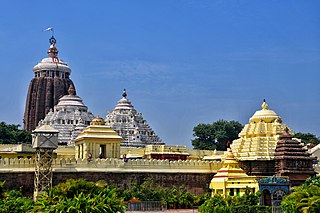
The Jagannath Temple is an important Hindu temple dedicated to Jagannath, a form of Vishnu - one of the trinity of supreme divinity in Hinduism. Puri is in the state of Odisha, on the eastern coast of India. The present temple was rebuilt from the tenth century onwards, on the site of pre existing temples in the compound but not the main Jagannatha temple, and begun by Anantavarman Chodaganga, the first king of the Eastern Ganga dynasty.
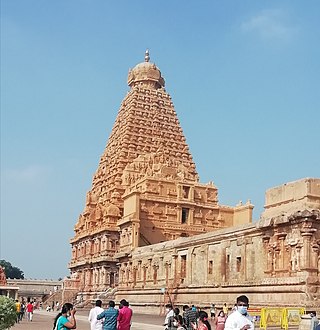
Brihadishvara Temple, called Rajarajesvaram by its builder, and known locally as Thanjai Periya Kovil and Peruvudaiyar Kovil, is a Shaivite Hindu temple built in a Chola architectural style located on the south bank of the Cauvery river in Thanjavur, Tamil Nadu, India. It is one of the largest Hindu temples and an exemplar of Tamil architecture. It is also called Dakshina Meru. Built by Chola emperor Rajaraja I between 1003 and 1010 CE, the temple is a part of the UNESCO World Heritage Site known as the "Great Living Chola Temples", along with the hola-era Gangaikonda Cholapuram temple and Airavatesvara temple, which are about 70 kilometres (43 mi) and 40 kilometres (25 mi) to its northeast respectively.

The Golden Temple is a gurdwara located in the city of Amritsar, Punjab, India. It is the preeminent spiritual site of Sikhism. It is one of the holiest sites in Sikhism, alongside the Gurdwara Darbar Sahib Kartarpur in Kartarpur, and Gurdwara Janam Asthan in Nankana Sahib.
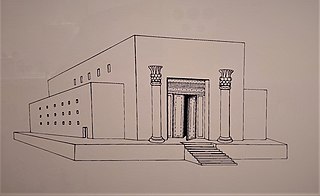
Solomon's Temple, also known as the First Temple, is a Temple in Jerusalem believed to have existed between the 10th and 6th centuries BCE. Its presumed existence is largely based on narratives in the Hebrew Bible, in which it was commissioned by the King Solomon of biblical legend before being destroyed during the siege of Jerusalem by King Nebuchadnezzar II of the Neo-Babylonian Empire in 587 BCE. Although most modern scholars agree that the First Temple existed on the Temple Mount in Jerusalem by the time of the Babylonian siege, there is significant debate over the date of its construction and the identity of its builder.
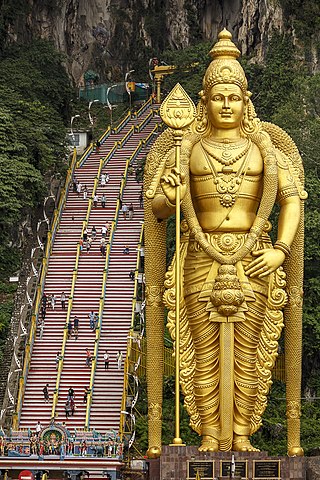
Kartikeya, also known as Skanda, Subrahmanya, Shanmukha, and Murugan, is the Hindu god of war. He is the son of Parvati and Shiva, the brother of Ganesha and a god whose legends have many versions in Hinduism. Kartikeya has been an important deity in the Indian subcontinent since ancient times, worshipped as Mahasena and Kumara in North India and is predominantly worshipped in the state of Tamil Nadu and other parts of South India, Sri Lanka, Singapore, and Malaysia as Murugan.
Konchiravila is a small settlement that lies near Manacaud in Thiruvananthapuram, India. It is around 3 km from East Fort and can be reached by local buses.



















